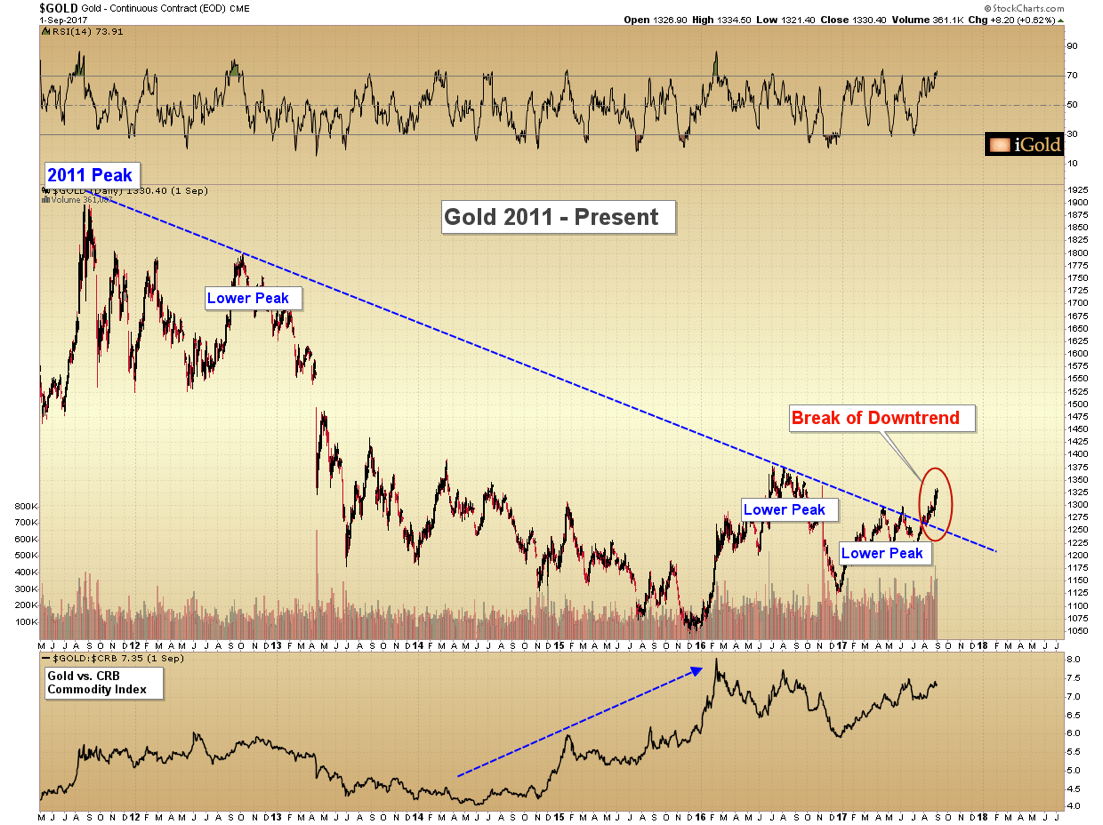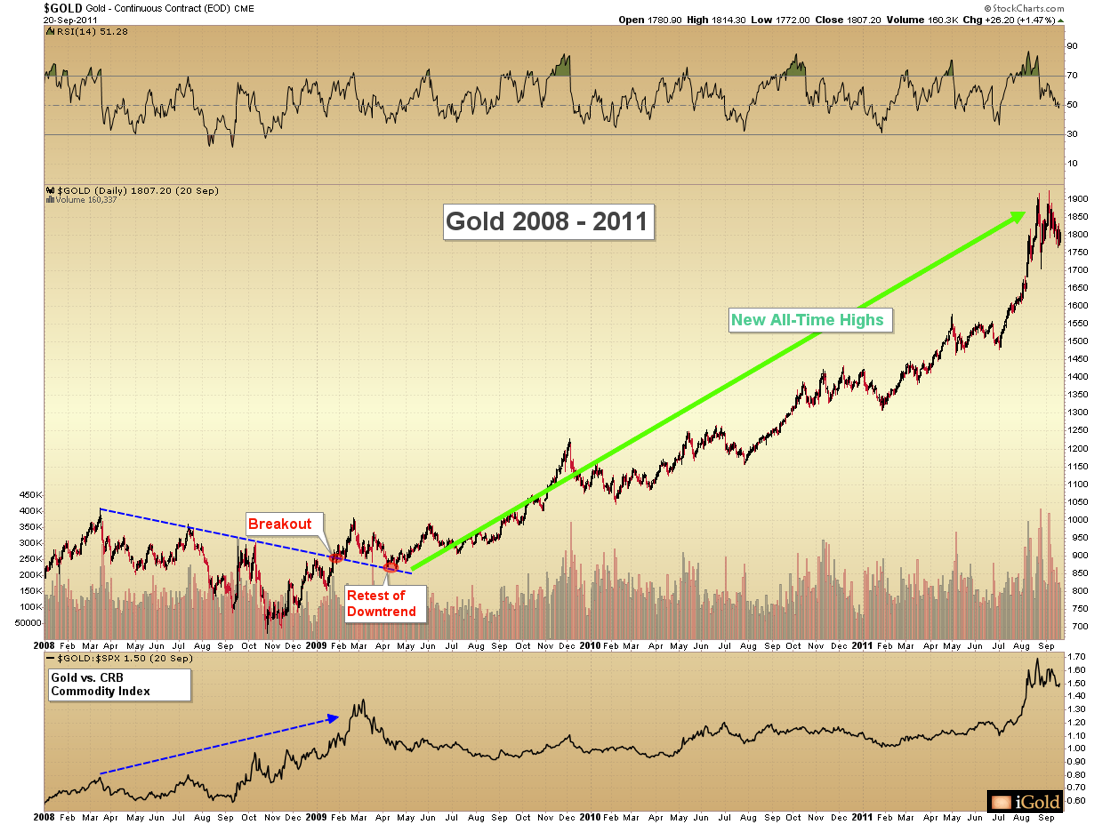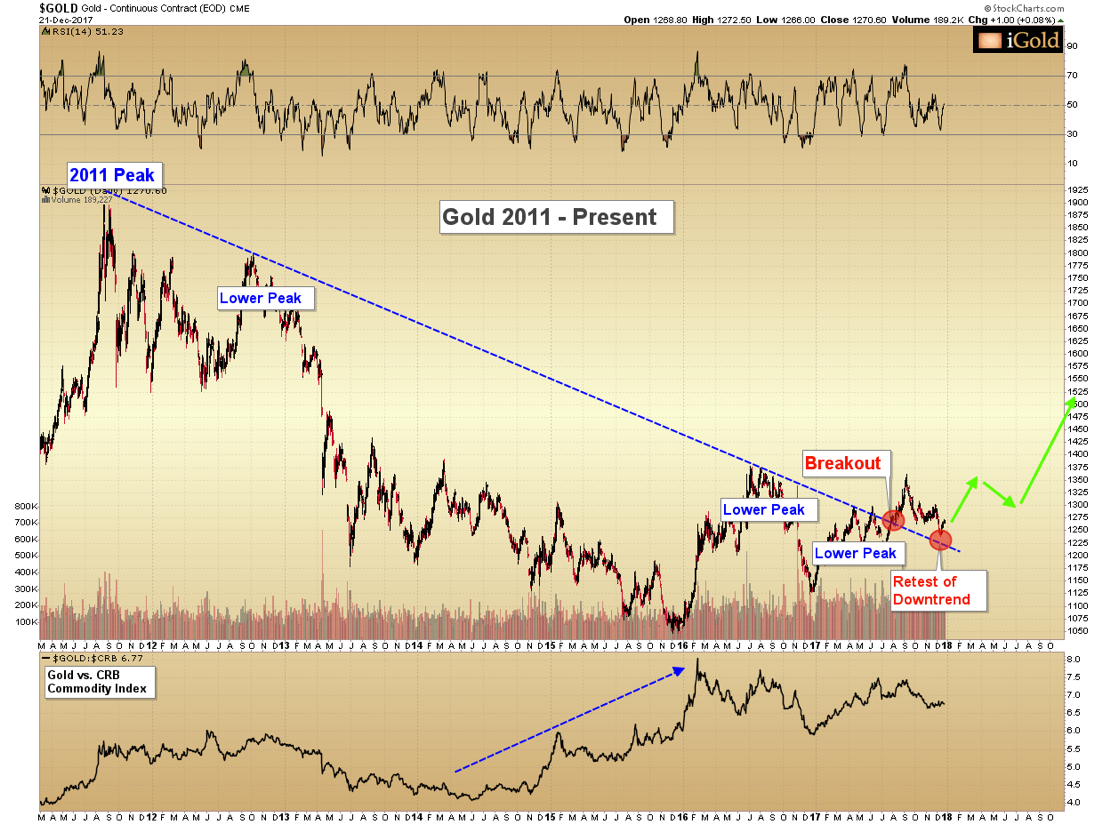2018 Gold Price Forecast: A Major Bottom Is Forming

Gold is now completing a pattern which repeats over and over again throughout history. The pattern suggests that a critical low is forming, and that the price of gold is set to begin a new primary advancing trend in 2018.
Note that we are not anticipating skyrocketing prices – such is the realm of headline hyperbole. Further, at this firm we have not been bullish on precious metals from 2011 through 2015. Regular readers will know that no bullish articles were published by this firm during that period: we were waiting for the proper technical signals to align which showed that the declines after 2011 had concluded.
Those signals are now visible. A new advancing trend in gold will set the stage for a markedly different backdrop which will impact short-term traders, investors, and mining companies alike. We must pay attention to these signals as they emerge now and before they are widely-known to avoid chasing markets higher – a strategy which usually results in severe losses.
Technical Backdrop
First, the technical backdrop: gold had been in a period of falling prices from 2011 through end-2015, characterized by a clear linear downtrend, which is visible on the chart below. Note the blue dashed line which marked a series of lower peaks in gold prices since the $1,923 high of 2011:
Aside from the clarity of the downtrend, the most noticeable feature of the gold chart is the break of the trend which occurred in August, 2017.
Finally, a higher intermediate-term peak was observed. The definition of a downtrend is declining peaks, and we can see on the chart that this trend was decisively broken last summer.
The challenge here is that many investors assume that when a downtrend is broken, it automatically means that prices are set to surge. This is not necessarily true.
Let us examine an example from history to see this principle in action: gold from 2008 – 2011.
Gold 2008 - 2011
Note that in 2008, after gold made a new all-time high at $1,033 per ounce, the price then began to weaken and formed a series of lower peaks into early 2009.
Finally, in February 2009, gold broke this trend of lower peaks:
Although the trend of declining peaks had ended, and gold made a functional (within 5%) challenge of former highs, the metal again began to decline in March and April 2009.
By mid-April, 2009, gold had fallen back to $865 from the price over $1,000 a few months earlier, a 13.5% decline. Those who were not paying attention to the break of the trend – who were only looking at price alone – did not see that gold was in fact forming a critical retest of this now-broken downtrend.
Indeed, many investors sold their metals at the $865 low retest in April 2009, believing that since gold had failed to advance over the past year it was time to sell.
Was this the right decision?
Let us advance the chart a few more years. Note the above chart showing the blue downtrend is now compressed into the lower left, yet the critical nature of the retest of the downtrend is no less significant:
On Retests
The takeaway here is that monitoring price alone is not sufficient for success. We must pay attention to trends in price as they develop – and even more importantly, to pay attention as trends change.
Gold had broken its series of declining peaks in early 2009 before the price began to advance in a major new uptrend that resulted in new all-time highs more than 100% above previous peaks.
Yet the 13.5% drop into April, 2009 was scary at the time. In today’s terms, that would equal a $171 drop in gold prices. Would we be scared and sell in such a scenario today?
Only if we were not paying attention to trend analysis.
Returning to the first chart in this article, we can see that the 13.5% loss in April 2009 in fact represented a retest of the former series of declining peaks.
A retest is a technical term for when a market attempts to establish a new trend, but then retreats back one last time – just to make sure that the new buyers are as determined as they appeared to be several months earlier on the breakout.
It is important to know that retests of broken trends can occur at a lower price point than the original breakout. This is perfectly acceptable. What is critical is that the trend of lower peaks must have ended.
The Power Of Trend Breaks
We can see the power of a broken trendline, followed by a successful retest, in the establishment of a new primary advance, as began in gold a few months later in September 2009. The gains were spectacular for those who did not sell during the retest, and rode the new bull market higher for the next several years.
The key is: one needed to not have sold on the retest, which indeed was a scary decline at the time. I remember several investors who sold gold at $865 on the retest, who were not aware of the power of trend breaks. Those were costly mistakes.
Fast Forward To Today
Return to the first chart of this article: gold has broken an even longer and more important downtrend, which extended back to 2011.
Let us now examine the most updated version of the chart. What do we see as prices have declined since August back down to $1,236 last week?
Nothing less than a retest of the even more significant long-term downtrend.
This is the exact same technical setup as in April 2009, it is simply playing out on a longer timescale. Yet the significance of the price action is no less important.
From the recent peak in September of $1,363 to the bottom last week of $1,236, gold declined 9.5%. This is less than the 13.5% decline which occurred in 2009. Yet again, the significance is that this decline represents a retest of the broken 2011 – 2017 downtrend.
History Rhymes
It is said that in life and in the markets, history does not repeat but it often rhymes.
We see over and over again that human beings move in patterns: sleep patterns, travel patterns, and relationship patterns are all examples of ways in which human beings move through the world in repeating cycles.
The markets are a component of human nature, and in the markets we can observe repeating patterns just the same as in other areas of human behavior:
Takeaway On Precious Metals
This is not the time to be bearish on precious metals. A critical technical retest of a broken trend is nearly completed.
This cycle is taking much longer to play out than the 2008 – 2009 cycle, but the pattern is equivalent in importance. We do not envision skyrocketing prices into 2018, but the establishment of a new primary rising trend is setting up. This should hold significant ramifications for investors, short-term traders, and mining companies who must forecast revenue through price models.
Let us watch to see this retest complete. Gold should fall no lower than $1,205 on a worst-case basis. Weakness should be temporary in nature going forward, and a rising trend should emerge from this bottom.
Many investors have sold into this recent 9.5% decline, having grown frustrated with what appears to be flat prices over the last several years. To those with the proper technical lens, we see evidence of something more powerful developing below the surface for gold in 2018.
*********























